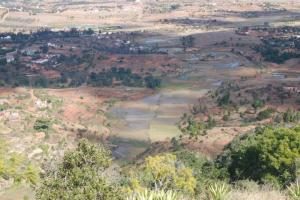
MAX-PLANCK-GESELLSCHAFT—The colonization of Madagascar remains one of the enduring mysteries of the ancient world. Situated off the East African coast, and many thousands of kilometers from Southeast Asia, Madagascar is nonetheless home to people who speak a language that is closely related to those spoken in the Pacific Area. While genetic research has confirmed that the inhabitants of Madagascar do indeed share close ancestry with Malaysians and Polynesians, archaeologists have struggled for decades to find any evidence for their early presence on the island. By analyzing the remains of ancient crops preserved in archaeological sediments, an international research team, including Max Planck director Nicole Boivin, has provided the first on-the-ground clues for this missing component of Madagascar’s past.
Examining residues obtained from a process called flotation, which uses a system of sieves and water to remove ancient preserved plant remains from sediments, the researchers identified 2443 individual crop remains to species level under the microscope. The remains were obtained through archaeological excavations at 18 ancient settlement sites in Madagascar, the Comoros and coastal eastern Africa.
“What was amazing to us was the stark contrast that emerged between the crops on the Eastern African coast versus those on Madagascar,” says Alison Crowther, of The University Queensland, lead author of the study, “and the more we looked, the starker the contrast became.” The ancient crop findings on the eastern African coast and nearest islands were heavily dominated by African crops – species like sorghum, pearl millet and baobab that had been present on the east African coast already for some centuries, brought by farmers across the continent. In contrast, samples taken from sites on Madagascar contained few or no African crops. Instead, they were dominated by Asian species like Asian rice, mung bean and Asian cotton.
The team examined where else in the Indian Ocean these crops were grown and also drew on historical and linguistic data. On this basis, the researchers were able to make a strong case that the crops reached Madagascar from Island Southeast Asia. “There are a lot of things we still don’t understand about Madagascar’s past, it remains one of our big enigmas” says Nicole Boivin, Director of the new Department of Archaeology at the Max Planck Institute for the Science of Human History in Jena and senior author on the study. “But what is exciting is that we finally have a way of providing a window into the island’s highly mysterious Southeast Asian settlement, and distinguishing it from settlement by mainland Africans that we know also happened. Southeast Asians clearly brought crops from their homeland and grew them and subsisted on them when they reached Madagascar. This means that archaeologists can use those remains to finally start to provide real, material insights into the colonization process.”
One such insight is that it was not only Madagascar that was settled by Southeast Asians, but also the nearby archipelago of the Comoros, which sits between Madagascar and the northern Mozambique coast. “This took us by surprise,” notes Crowther “after all, people in the Comoros speak African languages, and they don’t look like they have Southeast Asian ancestry the way that populations on Madagascar do.” Linguistic evidence, however, does provide some support for the researchers’ idea. “When we started looking more closely into research that has been carried out on Comorian languages,” pointed out Boivin “we were able to find numerous esteemed linguists who had argued for the exact thing we seemed to be seeing in the Comorian archaeological record – a settlement by people from Southeast Asia”.
_______________________________________
Even today, there are still many rice fields in the highlands of Madagascar. Settlers from Southeast Asia brought the grain to the island more than 1,000 years ago. Credit: Mark Horton/University of Bristol
___________________________________________________
Much work remains to be done. “We are keen to understand who these people were and what impact they had”, says Crowther. “Amongst events that possibly coincide with the arrival of Austronesian speakers is the disappearance of Madagascar’s famous megafauna, which include giant species of birds, lemur, and tortoises.” The team plans to return to Madagascar to continue their research. Boivin and Crowther are setting up new laboratories at the Max Planck Institute for the Science of Human History and University of Queensland that will collaborate closely in coming years.
The results of the research* has been published in the Proceedings of the National Academy of Sciences.
Source: Max-Planck-Gesellschaft news release.
___________________________________________________
*Alison Crowther, Leilani Lucas, Richard Helm, Mark Horton, Ceri Shipton, Henry T. Wright, Sarah Walshaw, Matthew Pawlowicz, Chantal Radimilahy, Katerina Douka, Llorenç Picornell-Gelaber, Dorian Q Fuller, and Nicole Boivin, Ancient crops provide first archaeological signature of the westward Austronesian expansion, Proceedings of the National Academy of Sciences.
___________________________________________________

______________________________________________
Travel and learn with Far Horizons.
____________________________________________
This richly illustrated issue includes the following stories: Recent findings shedding new light on the whereabouts of the remains of Philip of Macedon, father of Alexander the Great; how an archaeologist-sculptor is bringing bones of the dead back to life; archaeologists uncovering town life at the dawn of civilization; an exclusive interview with internationally acclaimed archaeologist James M. Adovasio about what makes the Meadowcroft Rockshelter prominent in the ongoing search for the first Americans; what archaeologists are finding at the site of the ancient city of Gath, the home town of the biblical Philistine giant, Goliath; and how scientists are redrawing the picture of human evolution in Europe. Find it on Amazon.com.









